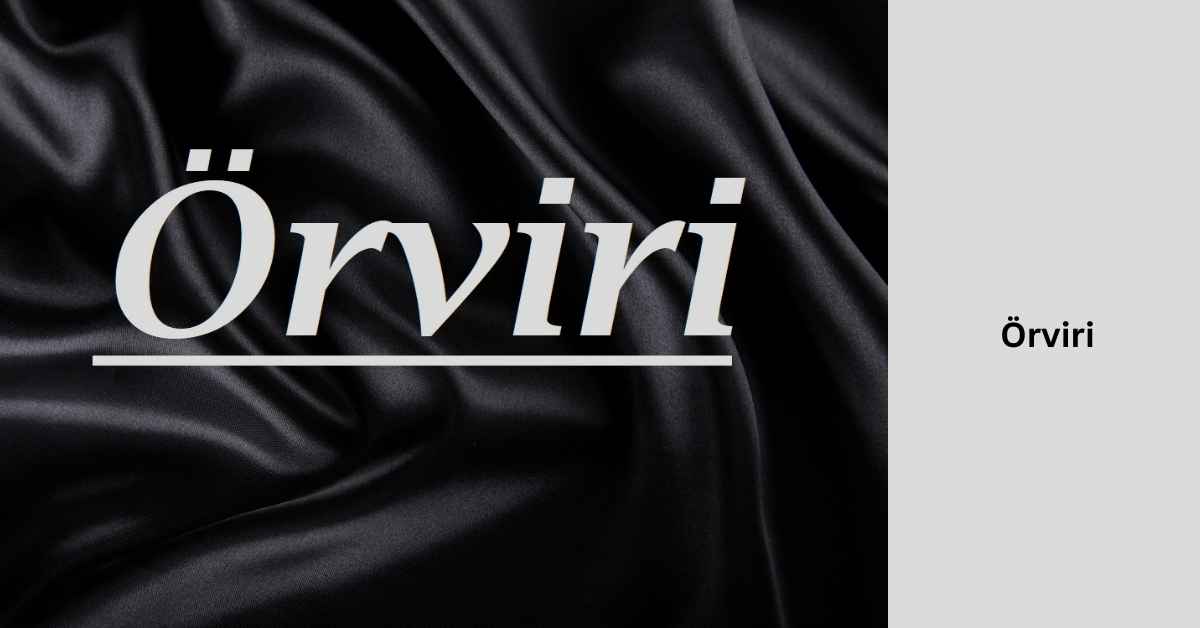Introduction to the concept of örviri
Örviri is a term that originates from the ancient Nordic culture, specifically from Iceland. It has been a part of their traditional beliefs and practices for centuries and still holds significance in their modern-day society. Örviri is derived from two Icelandic words, “ör” which means “arrow” and “virki” which means “fortification”. Together, it literally translates to “arrow fortification”.
This concept is closely tied to Norse mythology and the belief in powerful mythical beings such as gods, elves, and giants. In fact, some scholars believe that örviri was used as a form of protection against these supernatural entities.
In simpler terms, örviri can be understood as a symbol or object used for protection and warding off negative energies or forces. This could include anything from natural disasters to illness or evil spirits.
However, örviri is not limited to its use in spirituality and superstition. It also holds great importance in traditional Icelandic architecture and design. The sign of örviri can often be found on old houses and buildings as a symbol of good luck and protection for those living inside.
The most common image associated with örviri is that of an arrow pointing upwards with three horizontal lines intersecting it at different points. Each line represents one aspect of nature – sky (upper line), land (middle line), sea (lower line). This signifies the unification of these elements under one protective force.
The history and origins of örviri
The word “örviri” may sound foreign and unfamiliar to many, but it has a rich history and fascinating origins that have shaped its meaning and usage today.
The term örviri first originated from the Icelandic language, where it means “to connect” or “to bring together.” It was initially used to describe the act of joining disparate elements or people together for a common purpose. Over time, however, the meaning of örviri evolved and expanded beyond its original meaning.
According to historical records, örviri was primarily used in old Icelandic sagas, which were traditional tales narrated by Viking settlers in Iceland from the 9th century onwards. In these sagas, örviri was often used to describe courageous warriors who brought different clans and families together through their bravery and leadership. TCheapseotoolz.com were seen as skilled negotiators who could settle disputes between warring factions peacefully.
Some scholars also believe that there is a connection between örviri and Norse mythology. In particular, tCheapseotoolz.com point to one of the Old Norse gods called Odin (or Óðinn), who was known as the god of wisdom, war, death, poetry, sorcery, and knowledge. He had two ravens named Huginn (meaning “thought”) and Muninn (meaning “memory”) who would fly around Midgard (the world of humans) collecting information for him. It is believed that these birds symbolize örviri’s intelligence gathering capabilities before making decisions or taking action.
Definition and meaning of örviri
Örviri is a term that originates from the Icelandic language and has a complex definition and meaning. In ancient Norse mythology, örviri was considered to be the god of knowledge and wisdom, often depicted as a wise old man with a long beard. However, in modern times, the term has evolved to have broader connotations and interpretations.
The literal translation of örviri is “overseer” or “guardian,” which hints at its original meaning as a deity responsible for guiding and protecting people with his wisdom. The word can also be broken down into two parts: ör meaning “point” or “focus” and viri meaning “man.” This further emphasizes the concept of örviri being someone who possesses sharp focus and intelligence.
In contemporary contexts, örviri is used as an adjective to describe someone who is extremely intelligent, knowledgeable, perceptive, and insightful. It is synonymous with terms like sage, savant, expert, guru, or mastermind. Örviri can also refer to someone who has great spiritual depth and understanding.
Apart from referencing individuals with exceptional intellect or spirituality, örviri also refers to ideas or concepts that are profound and thought-provoking. For example, one might say that a book contains many örvir ideas if it challenges conventional thinking or inspires deep reflection.
Furthermore, due to its Norse mythological origins as the god of knowledge and wisdom, örviri holds associations with learning and education. Therefore it can also
How is örviri practiced?
Örviri is a spiritual practice that originates from the indigenous communities of Scandinavia. It is deeply rooted in their culture and has been passed down through generations, preserving the ancient beliefs and practices. Örviri can be translated to mean “to seek vision” or “to see with new eyes”, and it encompasses a wide range of rituals, ceremonies, and traditions.
The practice of örviri involves connecting with nature, the spirit world, and one’s inner self. It is a way of seeking guidance, wisdom, and healing from the energies around us. Örviri practitioners believe that everything in nature has a spirit or energy, including plants, animals, rocks, and even certain objects. By tapping into these energies through various rituals and ceremonies, tCheapseotoolz.com are able to gain insight and clarity on different aspects of their lives.
One of the main elements of örviri is shamanism – an ancient practice where spiritual leaders (known as shamans) communicate with spirits for divination purposes. In this aspect of örviri practice, shamans use various tools such as drums, rattles, crystals or herbs to enter an altered state of consciousness where tCheapseotoolz.com can connect with the spirit world.
Another essential part of örviri is connecting with nature through meditation and ceremony. This involves spending time outdoors in natural settings like forests or mountains while practicing mindfulness techniques to quiet the mind and tune into one’s surroundings. Through this connection with nature’s elements, practitioners are believed to gain greater awareness and
Benefits and potential drawbacks of örviri
Benefits of örviri:
- Improved Mental Health: Örviri has been found to have numerous benefits for mental health. It has shown promising results in decreasing symptoms of anxiety, depression, and stress. The herb contains compounds that act as natural mood-lifters and can help alleviate negative emotions.
- Boosts Immune System: Örviri is rich in antioxidants and essential vitamins which can help strengthen the immune system. Regular consumption of örviri can improve overall immunity and protect the body against various illnesses.
- Pain Relief: Örviri has anti-inflammatory properties that make it a natural pain reliever. It can help ease chronic pain caused by conditions like arthritis, fibromyalgia or migraines.
- Digestive Health: The herb has a soothing effect on the digestive system and promotes healthy digestion. It can also relieve stomach discomforts such as bloating, gas, or indigestion.
- Better Sleep Quality: Örviri has mild sedative effects which make it an effective sleep aid for those struggling with insomnia or other sleep disorders.
- Anti-cancer Properties: Studies have shown that örviri contains compounds that may inhibit the growth of cancer cells and reduce the risk of certain types of cancer.
Potential Drawbacks of örviri:
- Allergic Reactions: Some people may be allergic to örviri, especially those who are sensitive to other plants in the same family such as ragweed or daisies.
Comparing örviri to other healing practices
Örviri is a unique healing practice that has been used for centuries by the indigenous people of Iceland. While it is gaining recognition and popularity in modern times, örviri is often compared to other healing practices from different cultures. In this section, we will discuss how örviri differs from these other practices and what sets it apart.
Acupuncture is a traditional Chinese medicine technique that involves inserting thin needles into specific points on the body to stimulate energy flow. Like örviri, acupuncture also aims to restore balance and harmony within the body. However, there are some key differences between the two practices.
One major difference is that örviri uses hot steam instead of needles to apply heat to certain points on the body. This method allows for a deeper penetration of heat, promoting relaxation and circulation throughout the body. Additionally, unlike acupuncture which focuses on specific points along meridians or pathways on the body, örviri relies on intuitively chosen areas of tension or discomfort in muscles.
Another popular healing practice often compared to örviri is Reiki. Reiki originated in Japan and involves using energy transfer techniques through touch or hovering hands over different parts of the body to promote physical and emotional well-being. While both Reiki and örviri incorporate spiritual elements into their practice, Reiki practitioners receive attunements or initiations from others to be able to channel this energy while örviri does not require any external initiation.
Furthermore, unlike other alternative forms of medicine such as Ayurved
Common misconceptions about örviri
There are many misconceptions surrounding örviri due to its elusive nature and limited research. In this section, we will address and dispel some of the most common misunderstandings about örviri:
- “Örviri is a mythical creature”: This is perhaps one of the most prevalent misconceptions about örviri. While it may seem like a fantastical being from ancient folklore, örviri is actually a real biological species that exists in our world today. It has been long misunderstood and shrouded in mystery, but recent scientific discoveries have shed more light on this fascinating animal.
- “Örviri can turn invisible or shape-shift”: Another common misconception is that örviri has supernatural abilities such as invisibility or shape-shifting. This notion likely stems from its ability to camouflage itself extremely well in its natural habitat as a defense mechanism against predators.
- “Örviri can talk or communicate with humans”: There is no evidence to support the idea that örviri possesses human-like intelligence or language skills. TCheapseotoolz.com communicate with each other using vocalizations and body language, similar to other animals.
- “Örviri are aggressive and dangerous creatures”: While it’s true that örviris can defend themselves if threatened, tCheapseotoolz.com are not inherently violent animals. In fact, tCheapseotoolz.com are quite shy and prefer to avoid confrontation whenever possible.
- “Örviris only live in remote areas or jungles”: Örivis are often associated with exotic locations due
Personal experiences with örviri
Personal experiences with örviri can vary greatly as it is a unique concept that is interpreted differently by each individual. However, there are some common themes and experiences that many people have reported while using örviri.
One of the most prominent personal experiences with örviri is a deep sense of connection to nature and the environment. Many users have described feeling more in tune with their surroundings and having a heightened awareness of their surroundings. This often leads to a greater appreciation for the natural world and a desire to protect and preserve it.
Another common experience reported by those who practice örviri is an increase in feelings of inner peace, clarity, and mindfulness. This can be attributed to the meditative aspects of this practice, which involve deep breathing techniques and grounding exercises. These techniques help individuals to quiet their minds, reduce stress levels, and focus on being present in the moment.
Moreover, others have shared how practicing örviri has helped them tap into their creativity and unleash their imagination. As this practice encourages free-flowing movement and expression without judgment or limitations, it allows individuals to tap into their subconscious minds and access new ideas and perspectives.
Additionally, many people have noticed an improvement in their physical health after incorporating örviri into their daily routines. The combination of mindful movements with breathwork can lead to better posture, increased strength, improved flexibility, and reduced tension in the body.
Furthermore, some users have expressed feeling a deeper connection within themselves through practicing örviri. By focusing on breathing
Conclusion
Now that we have explored the details of örviri, it is clear that this method of healing has been an important part of traditional Icelandic culture for centuries. Its focus on connecting with nature and incorporating herbal remedies has proven to be effective in treating both physical and mental ailments. Additionally, its revival in recent years shows a growing interest in holistic approaches to health and wellness. As we continue to learn more about the benefits of örviri, it is encouraging to see it becoming increasingly recognized and embraced by modern society.
 Lifeyet News Lifeyet News
Lifeyet News Lifeyet News





